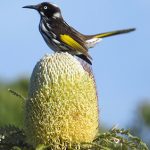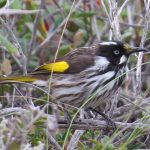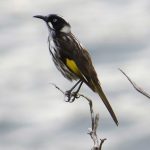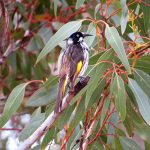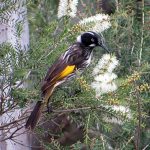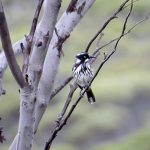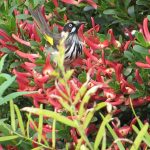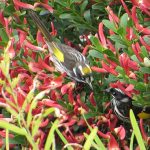NEW HOLLAND HONEYEATER
The New Holland Honeyeater has a distinctive appearance with black plumage on its head, wings, and back, contrasting with a white chest and underparts. It also features a striking yellow wing patch and a white eye ring. Males and females have a similar appearance, although males may have more extensive black plumage on the head.
They are found across a wide range of habitats in Australia, including forests, woodlands, heathlands, and coastal areas. They are particularly common in the southwest of Western Australia, along the southern coast, and in southeastern regions.
They are known for their loud and varied vocalizations. Their calls include a mix of harsh, buzzing sounds, whistles, and chattering notes. They use vocalizations for communication within their flock, territorial defense, and during courtship displays.
These honeyeaters have a varied diet. They primarily feed on nectar from a range of flowering plants, including banksias, eucalypts, and grevilleas. They also consume insects, spiders, and occasionally fruit and pollen.
New Holland Honeyeaters breed during the spring and summer months. They build a cup-shaped nest made of bark, grass, and other plant materials, often positioned in dense shrubs or trees. The female lays 2-3 eggs, which are incubated for around two weeks. Both parents share in the incubation and care of the young.
These honeyeaters are highly active and agile birds often seen foraging in the upper parts of trees, probing flowers with their long, curved beaks to extract nectar. They may also hover while feeding. They are territorial and defend their feeding and breeding territories against other bird species.
Habitat loss, fragmentation, and urbanization can impact their populations, particularly in more densely populated areas. They are relatively adaptable and can utilize modified habitats such as gardens and urban parks.
The New Holland Honeyeater is a visually striking bird with its contrasting black and white plumage and vibrant yellow wing patch. Their nectar-feeding behavior, diverse vocalizations, and active nature make them an interesting and engaging species to observe in the wild.

